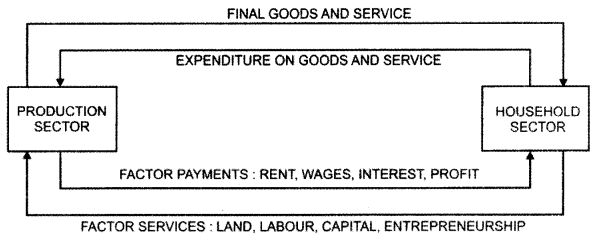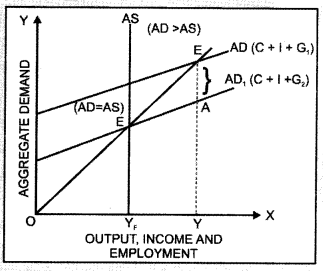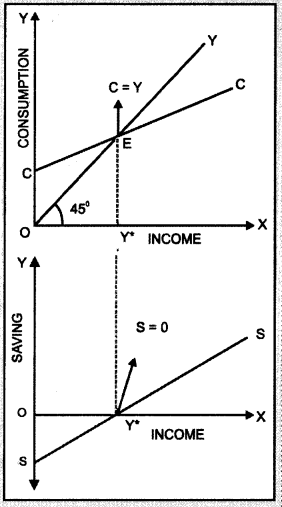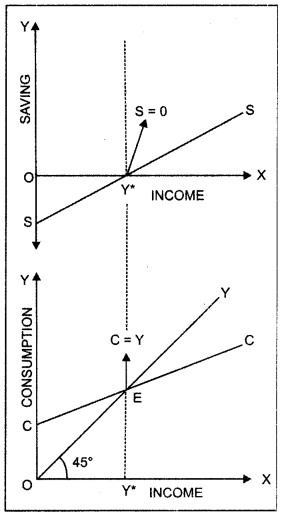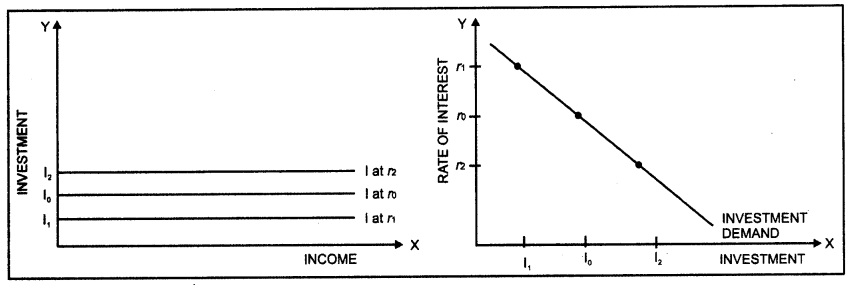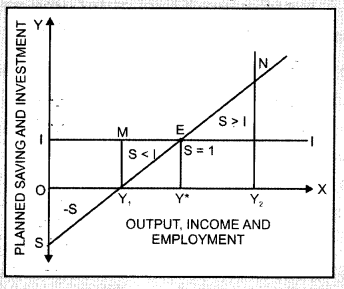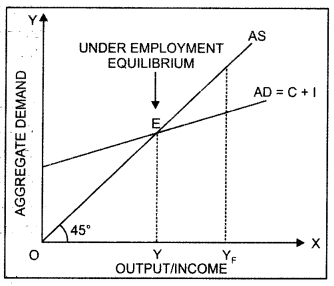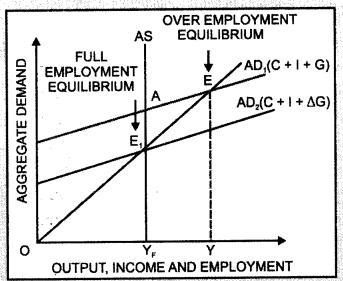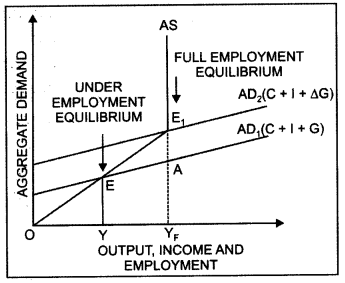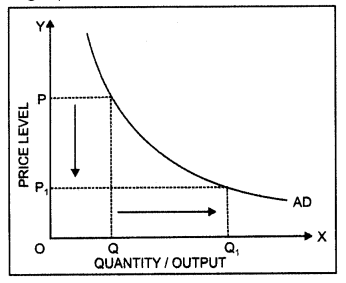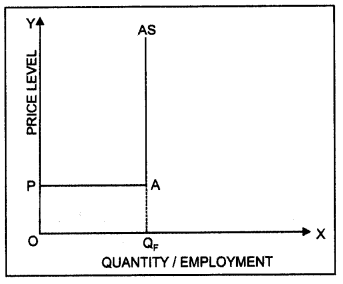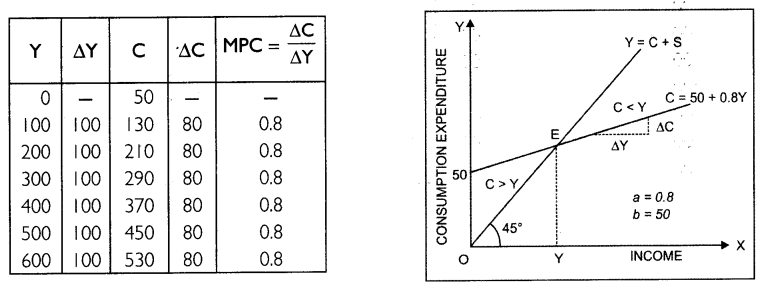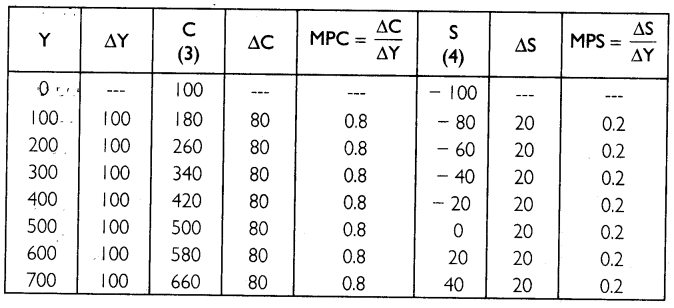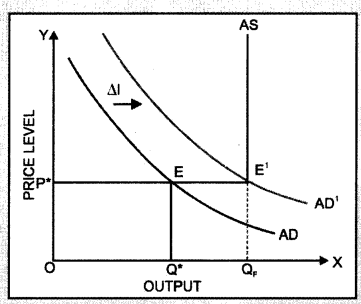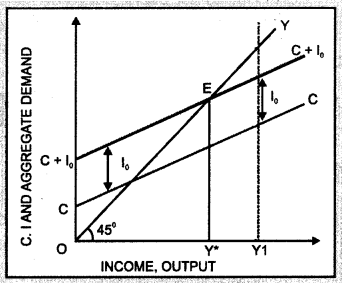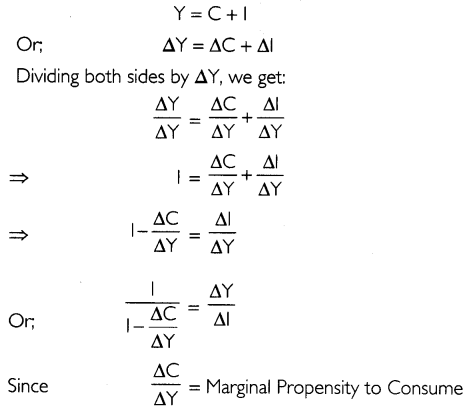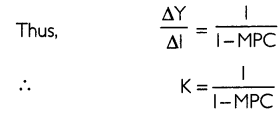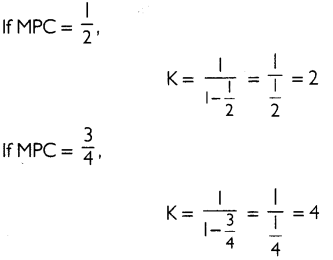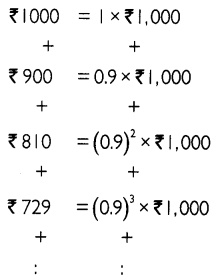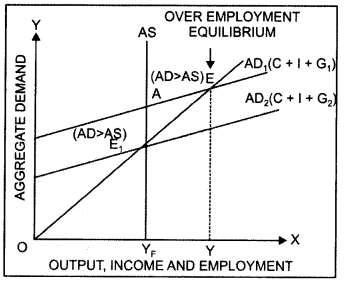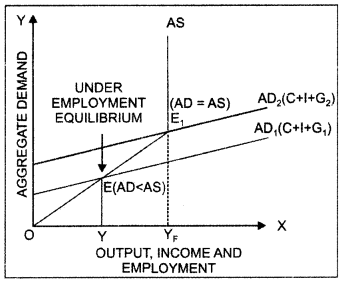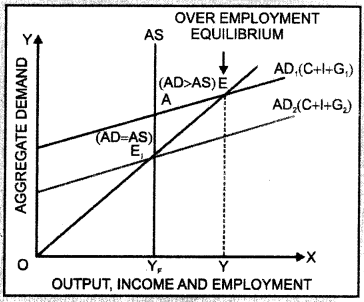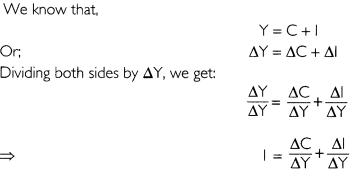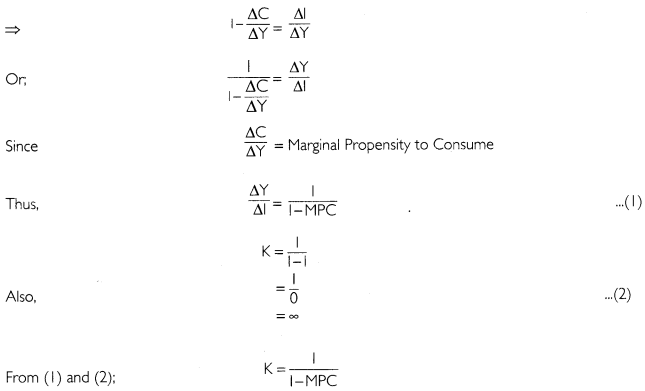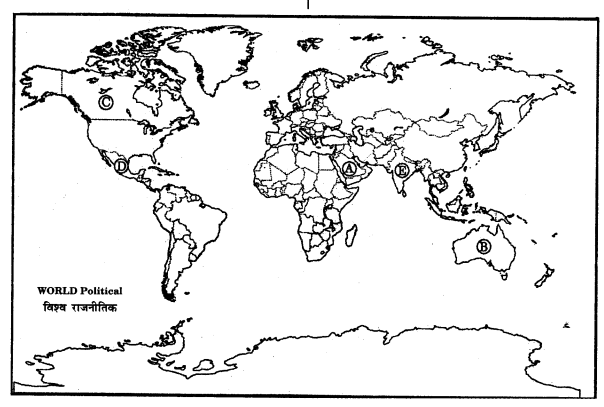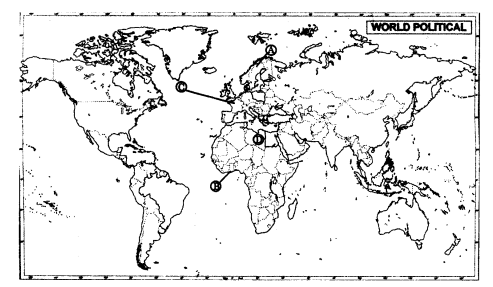Here we are providing Class 12 Economics Important Extra Questions and Answers Chapter 5 Government Budget and the Economy. Economics Class 12 Important Questions are the best resource for students which helps in class 12 board exams.
Class 12 Economics Chapter 5 Important Extra Questions Government Budget and the Economy
Government Budget and the Economy Important Extra Questions Very Short Answer Type
Question 1.
Define government budget. (C.B.S.E 2013, 2014, 2017)
Answer:
The government budget is an annual statement of the estimated receipts and expenditure of the government over the fiscal year, which runs from April 1 to March 31.
Question 2.
State any one objective of government budget.
Answer:
One of the primary objectives of the government budget is to mobilise resources for the purpose of rapid development.
Question 3.
Define surplus budget.
Answer:
A surplus budget is the one where the estimated revenues of the government are greater than the estimated expenditures,
Question 4.
Define a balanced budget.
Answer:
A balanced budget is the one where the estimated revenue of the government equals the estimated expenditure.
Question 5.
Define a deficit budget.
Answer:
A deficit budget is the one where the estimated revenue of the government is less than the estimated expenditure.
Question 6.
What is revenue expenditure?
Answer:
Revenue expenditure refers to that expenditure by the government, which neither creates assets for the government nor reduces its liabilities. For example, old-age pension.
Question 7.
Define capital expenditure.
Answer:
Capital expenditure refers to that expenditure by the government, which either creates assets for the government or reduces its liabilities.
Question 8.
Define a tax. (C.B.S.E. 2012,2019)
Answer:
Tax is a compulsory payment made by an individual or an institution to the government without anything in exchange
Question 9.
State any two sources of non-tax revenue receipts. (C.B.S.E 2011 Comp.)
Answer:
The two sources of non-tax revenue receipts are:
(i) Income from investment made by the government
(ii) Fees and fines received by the government
Question 10.
Why is entertainment tax an indirect tax?
Answer:
The entertainment tax is an indirect tax because the seller of the service passes the burden of tax on to the buyer of the service.
Question 11.
Define fine.
Answer:
Fines are amounts levied for an infringement of a law.
Question 12.
Define fiscal discipline.
Answer:
Fiscal discipline means having control over expenditures, given the quantum of revenues.
Question 13.
Define Direct tax (C.B.S.E. Outside Delhi 2012, 2019)
Answer:
Direct taxes are those taxes levied immediately on the property and income of persons, and are paid [ by-the consumers to the state.
Question 14.
Give Area examples of direct taxes. (C.B.S.E.20I0)
Answer:
Following are the three examples of direct tax-
(i) Income Tax
(ii) Wealth Tax
(iii) Interest Tax
Question 15.
What do you mean by an indirect tax? (C.B.S.E. Outside Delhi 2019)
Answer:
Indirect tax is a tax collected by an intermediary (seller) from the person who bears the ultimate economic burden of the tax (buyer), Its burden can be shifted by the tax payer on someone else.
Question 16.
Define GST (C.B.S.E. 2013)
Answer:
GST’ is a value-added tax paid by the consumers and remitted to the government by the seller of various goods and service
Question 17.
Give two examples of fees.
Answer:
Following are the three examples of fees:
(i) College fees in government colleges
(ii) License fees
Question 18.
Define fee.
Answer:
Fee refers to a payment to defray the cost of each recurring service undertaken by the government but conferring a special advantage on the fee payer.
Question 19.
State any two items of revenue expenditure in a Government budget. (C.B.S.E. 2019)
Answer:
Defence expenditure and expenditure on social services.
Question 20.
Indicate two heads of government expenditure on capital account.
Answer:
Acquisition of land or buildings, acquisition of plant machinery or equipment.
Question 21.
Write two heads of government development expenditure.
Answer:
Expenditure on economic services like agriculture, industry, etc., expenditure on education or health.
Question 22.
Point out two heads of non-development government expenditure.
Answer:
Defence expenditure and payments on administrative services.
Question 23.
What is meant by revenue deficit? (C.B.S.E 2004,09, 10,2017), (C.B.S.E. Outside Delhi 2013)
Answer:
Revenue deficit in the government budget represents the excess of current revenue expenditure over the current revenue receipts.
Question 24.
Define primary deficit. (C.B.S.E. 2004,2009,2017,2019)
Answer:
Primary deficit is the difference between fiscal deficit and interest payments. It indicates how much of the government borrowing is going to meet expenses, other than interest payments.
Question 25.
What is meant by fiscal deficit? (C.B.S.E. 2004, 05, 09, 2017, 2019)
Answer:
The fiscal deficit is the difference between the total expenditure of the government and the revenue receipts plus the capital receipts, which are not in the nature of borrowing, but which finally accrue to the government.
Question 26.
How is primary deficit calculated? (C.B.S.E 2010), (C.B.S.E Outside Delhi 2011 Comp.)
Answer:
Primary deficit is calculated as:
Primary deficit = Fiscal deficit – Interest payment.
Government Budget and the Economy Important Extra Questions Short Answer Type
Question 1.
What is a government budget? Name two sources each of non-tax revenue receipts and capital receipts.
Answer:
The government, budget is an annual statement of the estimated receipts and expenditure of the government over the fiscal year, which runs from April I to March 31.
Non-tax revenue receipts are the receipts received by the government in the form of prices paid for government supplied goods and services. The sources of non-tax revenue receipts include payments for postage and railway services.
Capital receipts of the government are those receipts, which either cause reduction in the assets or create a liability for the government. Small savings and deposits in the public provident fund are the two sources of the capital receipts.
Question 2.
What are the objectives of a budget?
Answer:
The objectives of a budget are as follows:
- Reallocation of Resources
- Reducing Inequalities in Income and Wealth
- Economic Stability
- Management of Public Enterprises
- Economic Growth
- Reducing Regional Disparities
Question 3.
How can a government budget help in reducing inequalities of income? Explain. (C.B.S.E. 2010,2017)
Or
How can budgetary policy be used to reduce inequalities of income? (C.B.S.E. Outside Delhi 2011,2013,2018)
Answer:
An important objective of the government budget is to reduce the income inequalities. The government budget helps in achieving the objective of reducing inequalities of income through progressive taxation.
Under progressive taxation, burden of the tax falls more on the rich and less on the poor. The rate of tax increases as the income increases. Thus, progressive tax is equitable. Appropriate expenditure policy in the government budget also helps in reducing the inequalities of income.
Question 4.
Explain the allocation function of a government budget. (C.B.S.E. 2010, 11, 12, 18), (2013 Comp.)
Answer:
The government aims to reallocate resources in a way so that its economic (profit maximisation) and social objectives (public welfare) are fulfilled. The government can influence allocation of resources through implementation of appropriate fiscal policy.
Production of goods, which are injurious to health is discouraged through heavy taxation. On the other hand, production of goods which are beneficial for society is encouraged through subsidies.
Question 5.
Explain the ‘redistribution of income’ objective of government budget. (C.B.S.E Outside Delhi 2011)
Answer:
The government budget shows its comprehensive exercise on the taxation and subsidies. The government imposes higher taxes on the rich and spends the revenue on the welfare of the poor. This helps in reducing inequalities in the distribution of income. Equitable distribution of income and wealth is a sign of social justice, which is the principal objective of any welfare state in India.
Question 6.
Explain the ‘economic stability’ objective of a government budget. (C.B.S.E Outside Delhi 2011,12,17)
Answer:
Free play of the market forces are bound to generate trade cycles, also called business cycles. These refer to the phases of recession and depression, recovery and boom in the economy. The government of a country is always committed to save the economy from business cycles.
The government budget plays a significant role in preventing business fluctuations due to inflation or deflation and hence, maintains economic stability. Economic stability stimulates investment, consequently, increasing the rate of growth and development.
Question 7.
What are externalities? Give an example of a positive externality and its impact on welfare of the people. (C.B.S.E. Outside Delhi 2014)
Answer:
Externalities refer to the harms (or benefits) a firm or an individual causes to another for which they are not penalised (or paid for). Externalities may be positive or negative. For example, Increase in government’s expenditure on education of individuals can lead to broader society benefits in the form of greater economic productivity, lower unemployment rate, greater household mobility and higher rate of political participation.
Question 8.
Define externalities. Give an example of negative externality. What is its impact on welfare? (C.B.S.E .2014)
Answer:
Externalities refer to the harms (or benefits) a firm or an individual causes to another for which they are not penalised (or paid for). Externalities may be positive or negative. For example, increase in GDP may be at the cost of considerable pains and sacrifices in the form of environment pollution.
As a result, increase in GDP may mean less economic welfare. If increase in GDP has been brought about by making wokers work in bad working conditions, increase in GDP will not raise the level of economic welfare.
Question 9.
Distinguish between revenue receipts and capital receipts. Give an example of each.
Or
How are capital receipts different from revenue receipts. Discuss briefly. (C.B.S.E 2019)
Answer:
The differences between revenue receipts and capital receipts are stated below:
| S.No. | Revenue Receipts | Capital Receipts |
| (a) | Revenue receipts neither create any liability nor reduce any asset of the government. | Capital receipts either create any liability or reduce any asset of the government. |
| (b) | They are regular and recurring in nature. | They are non-recurring in nature. |
| (c) | There is no future application to determine the amount. | In case of certain capital receipts, like browsing. there is future obligation to return the amount |
| (d) | Example: income tax, GST, non-tax revenue like interest, fees, etc. | Example: disinvestment, borrowings |
Question 10.
Distinguish between direct tax and indirect tax? Give an example of each. (C.B.S.E 2017), (C.B.S.E Outside Delhi 2011, Comp. 2017)
Answer:
Direct tax is a tax levied on the property and the income of persons. These are paid directly to the state by the consumers. Its burden cannot be shifted by the tax payer on someone else.
For example: Income tax.
Indirect tax is a tax collected by an intermediary (seller) from the person who bears the ultimate economic burden of the tax (buyer). Its burden can be shifted by the tax payer omsomeone else.
For example: Excise duty.
Question 11.
State three sources each of revenue receipts and capital receipts in government budget. (C.B.S.E. Outside Delhi 2013)
Answer:
Revenue receipts are those money receipts, which neither lead to reduction in assets, nor create a liability for the government. Sources of revenue receipts are:
- Tax revenue
- Fines
- License fee
Capital receipts, on the other hand, are those money receipts, which either create liability or cause a reduction in the assets of the governments. Sources of capital receipts are:
- Recovery of loans
- Public borrowings by the government
- Deposits in the public provident fund
Question 12.
Is the following a revenue receipts or a capital receipts in the context of government budget and why?
(i) Tax receipts
(ii) Disinvestment (C.B.S.E. Outside Delhi 2014)
Answer:
(i) Tax receipts are revenue receipts because these neither result in the creation of physical/ financial assets nor cause any reduction in the liabilities of the government.
(ii) Disinvestment is the opposite of investment. Disinvestment occurs when the government sells off its shares of public sector enterprises to the private sector. It is a capital receipt because it leads to reduction in the assets of the government.
Question 13.
Classify the following statements as revenue receipts or capital receipts. Give valid reasons in support of your answer.
(a) Financial help from a multinational corporation for victims in a flood affected area.
(b) Sale of shares of a Public Sector Undertaking (PSU) to a private company,Y Ltd.
(c) Dividends paid to the Government by the State Bank of India.
(d) Borrowings from International Monetary Fund (IMF). (C.B.S.E. Outside Delhi 2019)
Answer:
(a) Financial help from a multinational corporation for victims in a flood affected area is a revenue receipt as it neither creates any asset not reduces any liability of the government.
(b) Sale of shares of a Public Sector Undertaking (PSU) to a private company, Y Ltd. is a capital receipt as it reduces the assets of the government.
(c) Dividends paid to the Government by the State Bank of India area is a revenue receipt as it neither creates any asset not reduces any liability of the government.
(d) Borrowings from International Monetary Fund (IMF) is a capital receipt as it increases the liabilities of the government.
Question 14.
How are tax receipts different from non-tax receipts? Discuss briefly. (C.B.S.E. 2019)
Answer:
Tax receipts are revenue receipts because these neither result in the creation of physical/ financial assets nor cause any reduction in the liabilities of the government.
Non-tax receipts are the receipts received by the government in the form of prices paid for government-supplied goods and services. The sources of non-tax revenue receipts include payments for postage and railway services.
Question 15.
What is the basis of classifying government expenditure into:
(i) revenue expenditure and capital expenditure?
(ii) plan expenditure and non-plan expenditure?
Answer:
Revenue Expenditure and Capital Expenditure
Revenue expenditure refers to the expenditure, which neither results in the creation of the assets nor causes any reduction in the liabilities of the government. Capital expenditure refers to the expenditure, which either leads to the creation of the assets or causes a reduction in the liabilities of the government.
Plan Expenditure and Non-plan Expenditure
Plan expenditure is the expenditure incurred by the government to meet its planned development and investment outlay. Non-plan expenditure is the expenditure incurred on activities, which are beyond the scope of planned development outlay
Question 16.
Is the following revenue expenditure or capital expenditure on the context of government budget? Give reason.
(i) Expenditure on collection of taxes
(ii) Expenditure on purchasing computer (C.B.S.E. 2014)
Answer:
(i) Expenditure on collection of taxes is revenue expenditure because it neither results in the creation of physical/ financial assets nor causes any reduction in the liabilities of the government.
(ii) Expenditure on purchasing computer is a capital expenditure because it results in the creation of physical asset of the government.
Question 17.
What is meant by revenue deficit? What are the implications of this deficit?
Answer:
The excess of the government’s revenue expenditure over the revenue receipts is called the revenue deficit. Given the same level of the fiscal deficit, a higher revenue deficit is worse than a lower one. High revenue deficit implies that the government should follow contractionary fiscal policy, that is, increase tax and/or reduce spending.
In a less developed countries, it is difficult to force people to pay higher taxes or to cut expenditure on development activities. Thus, the government usually finance its revenue deficit through borrowings. A revenue deficit implies a repayment burden in the future, not matched by any benefits via investment. It leads to rise in the prices and hampers the progress of the economy.
Question 18.
What is meant by revenue deficit? What are the implications of this deficit?
Answer:
The excess of the government’s revenue expenditure over the revenue receipts is called the revenue deficit. Given the same level of the fiscal deficit, a higher revenue deficit is worse than a lower one.
High revenue deficit implies that the government should follow contractionary fiscal policy, that is, increase tax and/or reduce spending. In a less developed countries, it is difficult to force people to pay higher taxes or to cut expenditure on development activities.
Thus, the government usually finance its revenue deficit through borrowings. A revenue deficit implies a repayment burden in the future, not matched by any benefits via investment. It leads to rise in the prices and hampers the progress of the economy.
Question 19.
What is meant by fiscal deficit? What are the implications of a large fiscal deficit? (C.B.S.E 2012)
Or
What is ‘fiscal deficit’? What are its implications? (C.B.S.E. Outside Delhi 2012)
Answer:
Fiscal deficit is the excess of total expenditure of the government over its total revenue and the capital receipts, excluding the borrowings and other liabilities of the government. Alternatively, fiscal deficit is an aggregate of the budgetary deficit plus government borrowings and the other liabilities. Fiscal Deficit = Total Expenditure – Total Receipts (excluding borrowings)
Or
Fiscal Deficit = Total Expenditure – (Total Revenue Receipts + Non-debt Capital Receipts)
Or
Fiscal Deficit = Budgetary Deficit + Borrowings and the other Liabilities Implications.
The important implications of fiscal deficit are:
(i) Large budgetary and fiscal deficit is an indication that the government has been spending beyond its means.
(ii) The mounting fiscal deficit implies that the increase in the tax revenue is not consistent with the revenue requirements of the government or that the tax collections are relatively sluggish. The implication may also follow that the tax system is relatively less elastic.
(iii) The increasing fiscal deficit implies that the government’s reliance over market and other borrowings has been rising. Moreover, it implies that the burden of debt seivice has been increasing.
Question 20.
Can there be a fiscal deficit in a government budget without a revenue deficit?
Answer:
Yes, there can be a fiscal deficit in the government budget without a revenue deficit.
Revenue deficit refers to a situation where revenue expenditure of the government exceeds its total revenue receipts. Fiscal deficit, on the other hand, refers to a situation where the total expenditure of the government exceeds sum total of its revenue receipts and non-debt capital receipts (total receipts excluding borrowings). Fiscal deficit is possible in a government budget even without revenue deficit ; in the situations when:
(i) the revenue budget is balanced and capital budget shows a deficit:
or
(ii) the deficit in the capital budget is greater than the surplus in the revenue budget
Question 21.
What are the implications of revenue deficit? State two measures of reduce this deficit. (C.B.S.E Outside Delhi 2011 Comp.)
Answer:
The excess of the government’s revenue expenditure over the revenue receipts is called the revenue deficit.
Given the same level of the fiscal deficit, a higher revenue deficit is worse than a lower one. High revenue deficit implies that the government should follow contractionary fiscal policy, that is, increase tax and/or reduce spending. In a less developed countries, it is difficult to force people to pay higher taxes or to cut expenditure on development activities.
Thus, the government usually finance its revenue deficit through borrowings. A revenue deficit implies a repayment burden in the future, not matched by any benefits via investment. It leads to rise in the prices and hampers the progress of the economy. Measures to reduce the revenue deficit are following:
- Framing suitable policies
- Proper utilisation of revenue receipts
Government Budget and the Economy Important Extra Questions Long Answer Type
Question 1.
What is a government budget? Discuss its objectives.
Answer:
The budget is a government’s annual statement of estimated receipts and payments over the fiscal year, which runs from April I to March 31.
The main objectives of government budget are:
(i) Reallocation of Resources: The government aims to reallocate resources in a way so that its economic (profit maximisation) and social objectives (public welfare) are fulfilled. The government can influence allocation of resources through implementation of appropriate fiscal policy.
(ii) Reducing Inequalities in Income and Wealth: Another important objective of the government is to reduce income inequalities through its policies. The government imposes higher taxes on the rich and spends the revenue on the welfare of the poor. This helps in reducing inequalities in the I distribution of income.
(iii) Economic Stability: The government budget plays a significant role in preventing business fluctuations due to inflation or deflation and hence, maintains economic stability.
(iv) Management of Public Enterprises: A large numbers of public sector industries have been established and managed for the welfare of the public. The government budget provides financial support to these enterprises.
(v) Economic Growth: The rate of saving and investment in an economy determine the rate of economic growth. The budgetary policy, therefore, aims to mobilise sufficient resources for investment in the public sector.
(vi) Reducing Regional Disparities: It is an important objective of the government budget to reduce regional disparities through taxation and expenditure policy. For this, government provides funds for the setting up of production units in economically backward regions.
Question 2.
Describe the importance of government budget.
Answer:
The importance of budget can be explained with the help of following points:
(i) Economic Stability: Government can achieve economic stability through budget. During inflation, government makes the surplus budget, whereas during depression, it makes deficit budget. Prices can be stabilised through budget.
(ii) Economic Control: Government controls the whole parliament and councils through budget. Revenue can be properly utilised through budget.
(iii) Economic and Social Development: Budget has a great importance in economic and social development Government encourages industries and agriculture by giving subsidies through its budget and encourages production. In the same way, government imposes high taxes through budget on rich class and redistributes the revenue collected by these taxes among the poorer sections of the society.
(iv) Administrative Efficiency: Government decides the limits of working areas of every official and employment through its budget.
(v) Instrument of Fiscal Policy: Budget is an important instrument of the fiscal policy of the country. Fiscal policy is the policy of fixing its revenue and expenditure in a way that economic fluctuations are minimised.
Question 3.
Explain the importance of public expenditure.
Answer:
Importance of public expenditure has been increased due to the following reasons: –
(i) Increase in the Activities of the State: In the modern age, the activities of the state have been increased many times. There has been an extensive and intensive increase in the activities of central, state and local governments.
Now a days, governments undertake various activities such as to run, encourage and regularise the economic activities, to maintain economic stability, to secure poor and backward classes and to increase the rate of economic development, etc. There is a great importance of public expenditure in the completion of these activities.
(ii) Economic Planning: Developing countries like India has adopted the path of economic planning for the removal of problems like poverty, unemployment and for the development of the country. As a result, the government has to incur expenditure on large scale. There is a great importance of public expenditure in economic planning.
(iii) Removing Unemployment, Poverty and Income Inequalities: Public expenditure has a great importance for the reduction of chronic problems like unemployment, poverty and income inequalities.
Question 4.
What is the meaning of revenue deficit? What problems does it create?
Answer:
The concept of revenue deficit is simple and straight. The revenue deficit is defined as the excess of revenue expenditure over revenue receipts. Mathematically
Revenue Deficit = Revenue Expenditure – Revenue Receipts
For example, according to the government of India, Budget for the year 2005-2006 states:
Total Revenue Receipts = ₹ 3,09,322 crores Total Revenue Expenditure = ₹ 3,85,493 crores
Revenue Deficit = ₹ 3,85,493 – 3,09,322 = ₹ 76,171 crores In other words, there should be revenue surplus, which should be used for building projects or building assets which yield return. In fact, revenue surplus represents government savings, which can be used for financing development.
Revenue deficit represents a critical situation in the economy. Revenue deficit indicates the amount of current expenditure which cannot be met by revenue receipts. It implies that government is spending beyond its means. The government should either increase its tax/non-tax receipts or should cut its expenditure.
In poor countries, in the initial stages of economic development, often the situation arises when the government has to incur large expenditure on administration and maintenance (particularly on defence, police and law and order) but it is difficult to compel the poor people to pay high taxes. In such situations, the government meets its revenue deficit either through borrowing or through disinvestment. Borrowing by the government, on the other hand, creates the problem of repayment of debt. Disinvestment reduces the asset of the government.
Question 5.
Explain the meaning of the following: (C.B.S.E. 2018)
(i) Revenue Deficit
(ii) Fiscal Deficit
(iii) Primary Deficit
Ans.
(i) Revenue Deficit: Revenue deficit is the excess of current revenue expenditure over the current
revenue receipts.
Revenue Deficit = Current Revenue Expenditure – Current Revenue Receipts Current revenue expenditure includes both plan and non-plan expenditure of the government to be met through revenue receipts. Current revenue receipts include the net tax and non-tax revenue receipts of the central government.
Until the middle of 1970’s, the central government in India enjoyed revenue surplus as the revenue receipts of the central government exceeded the revenue expenditure. The phenomenon of revenue deficit made its appearance during the latter 1970’s.
(ii) Fiscal Deficit: Fiscal deficit is the difference between total expenditure of the government and its total revenue receipts and capital receipts excluding the borrowings and other liabilities of the government. Alternatively, fiscal deficit is the aggregate of budgetary deficit plus borrowings and other liabilities.
Fiscal Deficit can be calculated as below:
Fiscal Deficit = Total Expenditure – Total Revenue Receipts – Capital Receipts excluding borrowings.
(iii) Primary Deficit: Primary deficit is the difference between fiscal deficit and interest payments. It is the aggregate of budgetary deficit plus borrowings and other liabilities minus interest payments.
It can be calculated as:
Primary Deficit = Fiscal Deficit – Interest Payments Alternatively primary deficit can be evaluated as:
Primary Deficit = Budgetary Deficit + Borrowings and Other Liabilities – Interest Payments. The primary deficit in the central government budget in India was of the magnitude of? 19,502 crore in 2000-01 . which has increased to ? 31,317 crore in 2001 -2002.
Government Budget and the Economy Important Extra Questions HOTS
Question 1.
Is borrowing by the government a revenue receipt?
Answer:
No, borrowing by the government is not a revenue receipt because it creates a liability for the government for repayment.
Question 2.
Find budget deficit from the following data:
Answer:
| Items | (₹ in Crore) |
| 1. Revenue receipts | 40,000 |
| 2. Revenue expenditure | 30,000 |
| 3. Capital receipts | 30,000 |
| 4. Capital expenditure | 50,000 |
Budget Deficit = (Revenue Expenditure + Capital Expenditure) – (Revenue Receipts + Capital Receipts)
= (30,000 + 50,000) – (40,000 + 30,000)
= 80,000 – 70,000 = ₹ 10,000 crore
Question 3.
Is balanced budget an achievement for the government?
Answer:
Balanced budget is not always an achievement for the government. When the economy is in a state of depression, it is in fact suggested to increase government expenditure, even if it causes inflation in the economy.
